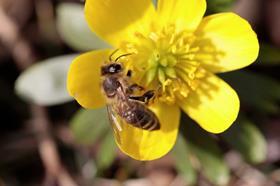
Pollinator populations have suffered “widespread” losses since 1980, with the number of insects such as bees and hoverflies dropping 25 per cent, according to a new study.
Published in the journalNature, the studypointed the finger to intensive farming, pesticide use, climate change in the north and the introduction of neonicotinoids in 2007 as major drivers of pollinator losses.
The evidence gathered population figures from 353 wild bee and hoverfly species between 1980 and 2013, with losses concentrated among the rarer species.
Overall a third (33 per cent) of insect pollinator numbers declined during the time period. The report did have some good news however, with dominant crop pollinators showing a 12 per cent increase thanks to agri-environmental practises.
Insect pollinators play a vital role in horticultural and the global food security with 75 per cent of crop species, and 35 per cent of global crop production dependent in some way upon insect pollination.
The report said there has been a “critical absence” of population monitoring of key pollinators such as wild bees and hoverflies.
Commenting on the report, Gareth Morgan, Soil Association head of policy, said:“Thecrash in pollinatorssince the 1980s is yet more grim news for British wildlife and is a stark warning that the government urgently needs to support farmers to reduce reliance on pesticides.
“With several of the pollinator declines coinciding with the introduction of neonicotinoids in 2007, thereport shows the ban on neonics was right and should be upheld, and echoeslast month’sresearchrevealing a steep decline in global insect populations linked tointensive farming and pesticide use. The UK urgently needs to transition to a more diverse farming landscape that can support pollinators with more flower-rich meadows and nesting areas, and less reliance onchemicals.”
The report’s message coincides with Asda suppliers IPL reporting a rise in sightings of rare insects thanks to their Operation Pollinator programme, which provides a special seed mix for their suppliers to create “green headlands” which provide insects with unploughed land on the edges of fields.
Monitoring of green headlands around its East Anglia farms has resulted in sightings of Lobe Spurred Furrow Bees, Spider Hunting Wasps Cuckoo Spider Hunting Wasps and Squat Furrow Bees, according to IPL.
Timm Brammer, IPL potato crop manager adds, “The Green Headland seed mix creates a wildlife corridor that wasn’t previously there and provides excellent benefits for biodiversity. The increased numbers of invertebrates and predators can assist with pest control and help to protect carrot and seed potato crops from aphids. Going forward, we’ll be encouraging all of our growers to plant the mix in their headlands rather than leave them bare.”



